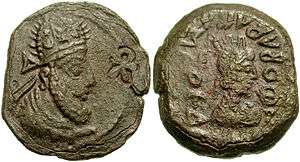Meredates of Characene

Meredates was a Parthian prince who ruled the state of Characene, a vassal of the Parthian Empire and important trading port, which he ruled from 131 to 150/151.
He is known to history only from coinage he minted and a single bronze statue.[1][2]
In 1984 a bronze statue was uncovered in Seleucia. The statue of Hercules has an inscription in Ancient Greek and Parthian inscribed on the thighs. The inscription reports that year 151 the Parthian King Vologases IV fought Meredates of Characene and the statue itself was brought out of Characene and set up in the Temple of Apollo in Seleucia.[3]
Meredates is also known from few coins, and by an inscription found in Palmyra. He was the son of Pacorus II of Parthia and as a result his coins clearly show a Parthian style. The coins' legends read "Meredates, son of Phokoros, King of Kings, King of the Omani".[4]
References
- ↑ Monika Schuol, The Characene. A Mesopotanian Kingdom in Hellenistic times (Oriens et Occidens. Volume 1).
- ↑ Josef Wiesehöfer, Ancient Persia. From 550 BC to 650 AD, Albatros in the Patmos publishing house). Patmos Verlag, Düsseldorf 2005, page169-170, table XVIb, c.
- ↑ Meredates had been placed on the Characene throne by his father Pacorus II of Parthia after the Romans had been driven out of Parthian area. However, that invasion had created civil war within the Parthian empire and Vologases IV of Parthia was the son of Pacorus II most bitter rival for the throne. Vologases IV had also tried to retake many other former provinces of the Parthian empire that had fallen independent during the War with Rome.
- ↑ The Omani is an Arab tribe ruled by of Characene
Sources
- (in German) Monika Schuol: Die Charakene. Ein mesopotamisches Königreich in hellenistisch-parthischer Zeit (= Oriens et Occidens. Band 1). Zugleich Dissertation Universität Köln, 1998. Steiner, Stuttgart 2000, ISBN 3-515-07709-X.
- (in German) Josef Wiesehöfer: Das antike Persien. Von 550 v. Chr. bis 650 n. Chr. (= Albatros im Patmos Verlagshaus). Patmos Verlag, Düsseldorf 2005, ISBN 3-491-96151-3, S. 169–170, Tafel XVIb, c.
| Meredates of Characene | ||
| Preceded by Attambelos VII |
King of Characene 131-150/51 |
Succeeded by Orabazes II |